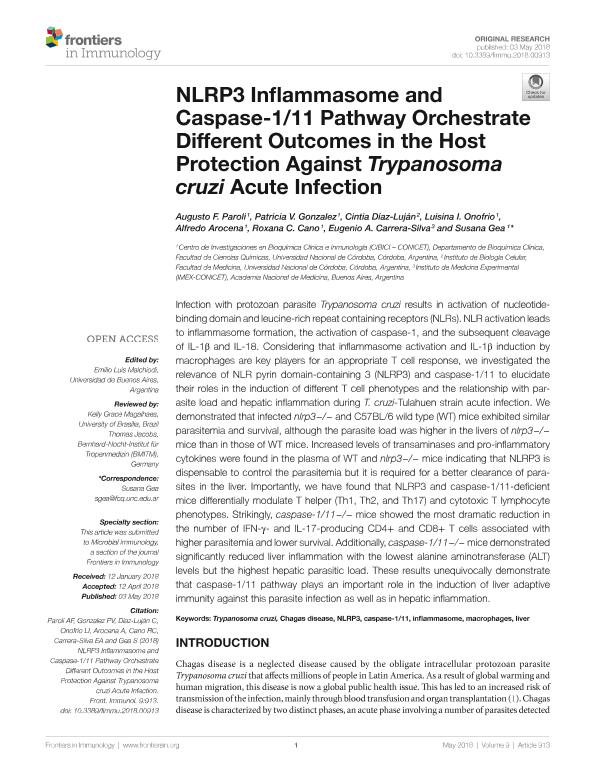Artículo
NLRP3 Inflammasome and Caspase-1/11 Pathway Orchestrate Different Outcomes in the Host Protection Against Trypanosoma cruzi Acute Infection
Paroli, Augusto Fabián ; Gonzalez, Patricia V.; Díaz Luján, Cintia María; Onofrio, Luisina Inés
; Gonzalez, Patricia V.; Díaz Luján, Cintia María; Onofrio, Luisina Inés ; Arocena, Alfredo Raul
; Arocena, Alfredo Raul ; Cano, Roxana Carolina; Carrera Silva, Eugenio Antonio
; Cano, Roxana Carolina; Carrera Silva, Eugenio Antonio ; Gea, Susana
; Gea, Susana
 ; Gonzalez, Patricia V.; Díaz Luján, Cintia María; Onofrio, Luisina Inés
; Gonzalez, Patricia V.; Díaz Luján, Cintia María; Onofrio, Luisina Inés ; Arocena, Alfredo Raul
; Arocena, Alfredo Raul ; Cano, Roxana Carolina; Carrera Silva, Eugenio Antonio
; Cano, Roxana Carolina; Carrera Silva, Eugenio Antonio ; Gea, Susana
; Gea, Susana
Fecha de publicación:
05/2018
Editorial:
Frontiers Media S.A.
Revista:
Frontiers in Immunology
ISSN:
1664-3224
Idioma:
Inglés
Tipo de recurso:
Artículo publicado
Clasificación temática:
Resumen
Infection with protozoan parasite Trypanosoma cruzi results in activation of nucleotide-binding domain and leucine-rich repeat containing receptors (NLRs). NLR activation leads to inflammasome formation, the activation of caspase-1, and the subsequent cleavage of IL-1β and IL-18. Considering that inflammasome activation and IL-1β induction by macrophages are key players for an appropriate T cell response, we investigated the relevance of NLR pyrin domain-containing 3 (NLRP3) and caspase-1/11 to elucidate their roles in the induction of different T cell phenotypes and the relationship with parasite load and hepatic inflammation during T. cruzi-Tulahuen strain acute infection. We demonstrated that infected nlrp3-/- and C57BL/6 wild type (WT) mice exhibited similar parasitemia and survival, although the parasite load was higher in the livers of nlrp3-/- mice than in those of WT mice. Increased levels of transaminases and pro-inflammatory cytokines were found in the plasma of WT and nlrp3-/- mice indicating that NLRP3 is dispensable to control the parasitemia but it is required for a better clearance of parasites in the liver. Importantly, we have found that NLRP3 and caspase-1/11-deficient mice differentially modulate T helper (Th1, Th2, and Th17) and cytotoxic T lymphocyte phenotypes. Strikingly, caspase-1/11-/- mice showed the most dramatic reduction in the number of IFN-γ- and IL-17-producing CD4+ and CD8+ T cells associated with higher parasitemia and lower survival. Additionally, caspase-1/11-/- mice demonstrated significantly reduced liver inflammation with the lowest alanine aminotransferase (ALT) levels but the highest hepatic parasitic load. These results unequivocally demonstrate that caspase-1/11 pathway plays an important role in the induction of liver adaptive immunity against this parasite infection as well as in hepatic inflammation.
Palabras clave:
CASPASE-1/11
,
CHAGAS DISEASE
,
INFLAMMASOME
,
LIVER
,
MACROPHAGES
,
NLRP3
,
TRYPANOSOMA CRUZI
Archivos asociados
Licencia
Identificadores
Colecciones
Articulos(CIBICI)
Articulos de CENTRO DE INV.EN BIOQUI.CLINICA E INMUNOLOGIA
Articulos de CENTRO DE INV.EN BIOQUI.CLINICA E INMUNOLOGIA
Articulos(IMEX)
Articulos de INST.DE MEDICINA EXPERIMENTAL
Articulos de INST.DE MEDICINA EXPERIMENTAL
Citación
Paroli, Augusto Fabián; Gonzalez, Patricia V.; Díaz Luján, Cintia María; Onofrio, Luisina Inés; Arocena, Alfredo Raul; et al.; NLRP3 Inflammasome and Caspase-1/11 Pathway Orchestrate Different Outcomes in the Host Protection Against Trypanosoma cruzi Acute Infection; Frontiers Media S.A.; Frontiers in Immunology; 9; 5-2018; 1-12
Compartir
Altmétricas



